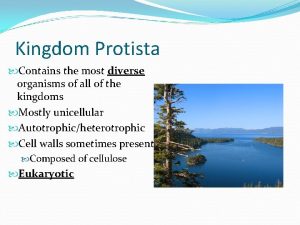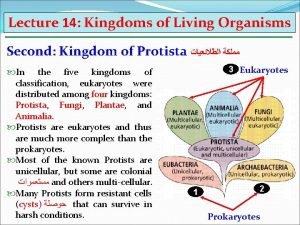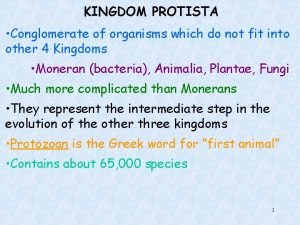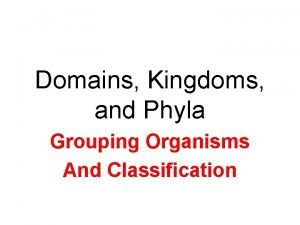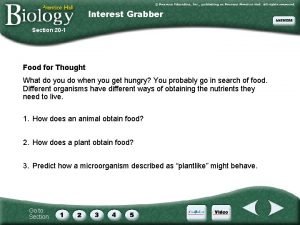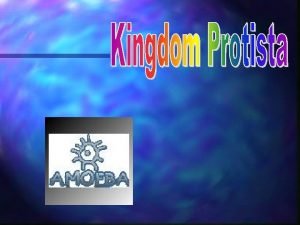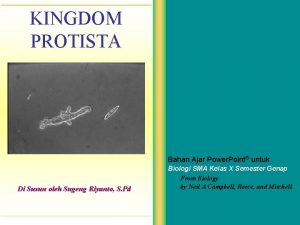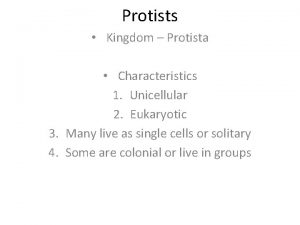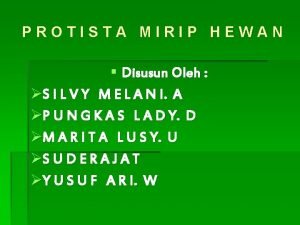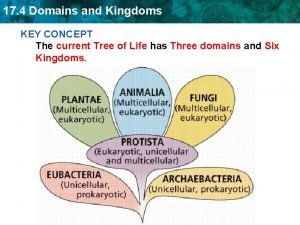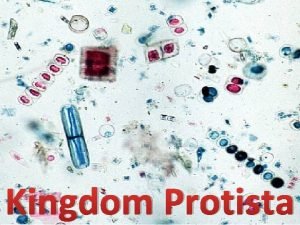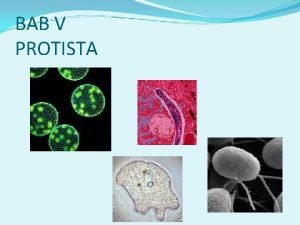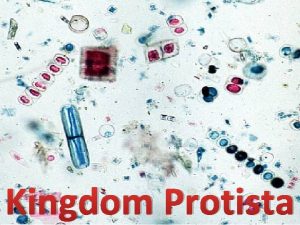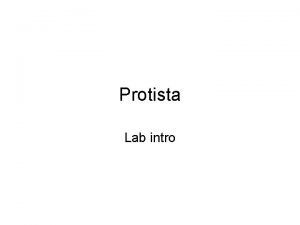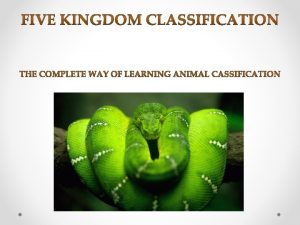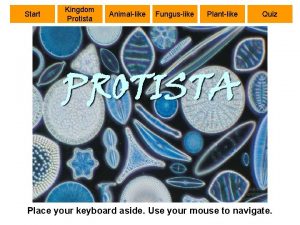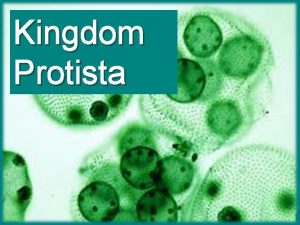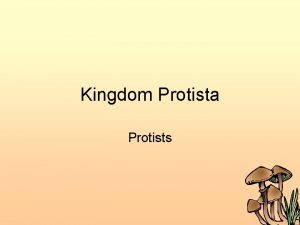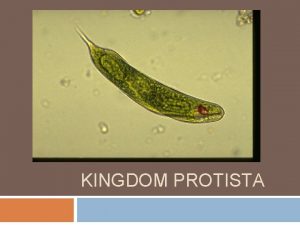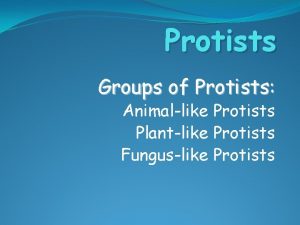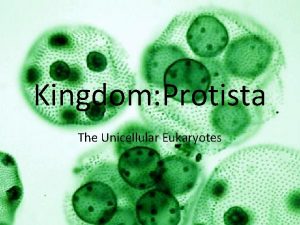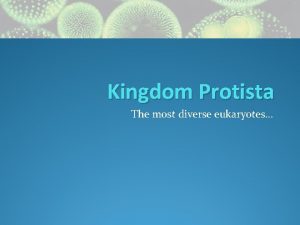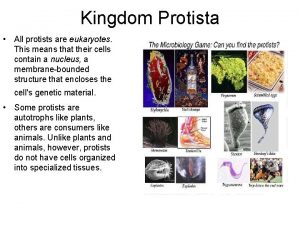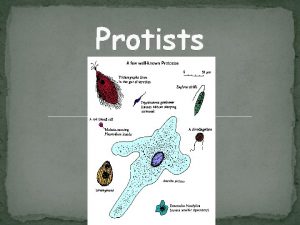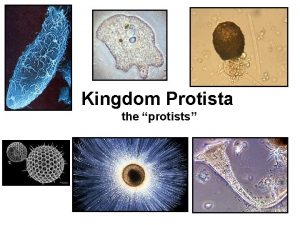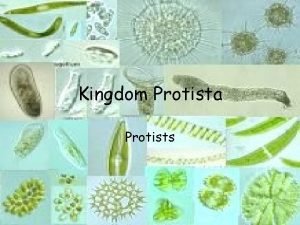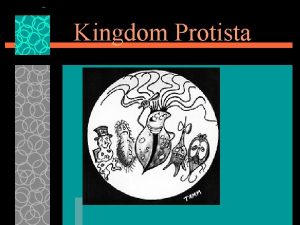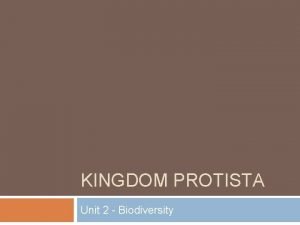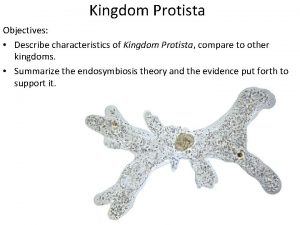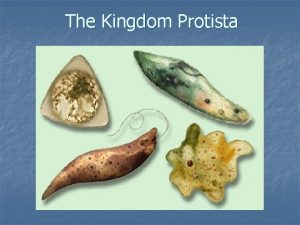Protists Are the Simplest Eukaryotes Kingdom Protista contains





























- Slides: 29

Protists Are the Simplest Eukaryotes Kingdom Protista contains eukaryotes that do not fit in any of the other three eukaryotic kingdoms. Section 15. 4 Amoeba: © Melba Photo Agency/Punch. Stock (RF) Copyright © The Mc. Graw-Hill Companies, Inc. Permission required for reproduction or display. Figure 15. 18

Protists Are the Simplest Eukaryotes Biologists traditionally organize protists into three main groups: • Algae • Slime molds/water molds • Protozoa Section 15. 4 Dismid: © M. I. Walker/Photo Researchers; slime mold: © Carolina Biological Supply Company/Phototake; paramecium: © Michael Abbey/Visuals Unlimited Copyright © The Mc. Graw-Hill Companies, Inc. Permission required for reproduction or display.

Protists Are the Simplest Eukaryotes Algae are aquatic, photosynthetic protists. dinoflagellates, diatoms, brown algae, red algae, and green algae are common types. Section 15. 4 Algal bloom: © Michael Marten/Photo Researchers Copyright © The Mc. Graw-Hill Companies, Inc. Permission required for reproduction or display.

Protists Are the Simplest Eukaryotes Dinoflagellates have two flagella and often produce toxins. Section 15. 4 Algal bloom: © Michael Marten/Photo Researchers; dinoflagellates: © Dr. David M. Phillips/Visuals Unlimited Copyright © The Mc. Graw-Hill Companies, Inc. Permission required for reproduction or display. Figure 15. 19

Protists Are the Simplest Eukaryotes Diatoms have silica cell walls and are abundant in all moist habitats. Section 15. 4 Algal bloom: © Michael Marten/Photo Researchers; diatoms (left): © Carolina Biological Supply Company/Phototake; diatom (right): © Steve Gschmeissner/Photo Researchers Copyright © The Mc. Graw-Hill Companies, Inc. Permission required for reproduction or display. Figure 15. 20

Protists Are the Simplest Eukaryotes Brown algae are large, multicellular protists. Kelps are the largest types. Section 15. 4 Algal bloom: © Michael Marten/Photo Researchers; kelp: © Ralph A. Clevenger/Corbis Copyright © The Mc. Graw-Hill Companies, Inc. Permission required for reproduction or display. Figure 15. 21

Protists Are the Simplest Eukaryotes Red algae have photosynthetic pigments that absorb red and blue wavelengths of light. Section 15. 4 Algal bloom: © Michael Marten/Photo Researchers; red alga: © Daniel W. Gatshall/Visuals Unlimited Copyright © The Mc. Graw-Hill Companies, Inc. Permission required for reproduction or display. Figure 15. 22

Protists Are the Simplest Eukaryotes Green algae are a diverse group with many similarities to land plants. Section 15. 4 Algal bloom: © Michael Marten/Photo Researchers; spirogyra: © Tom Stack/Tom Stack & Associates; Volvox: © Wim van Egmond/Visuals Unlimited; desmid: © M. I. Walker/Photo Researchers Copyright © The Mc. Graw-Hill Companies, Inc. Permission required for reproduction or display. Figure 15. 23

Protists Are the Simplest Eukaryotes Water molds, slime molds, and protozoa are mostly heterotrophic. Section 15. 4 Paramecium: © Michael Abbey/Visuals Unlimited Copyright © The Mc. Graw-Hill Companies, Inc. Permission required for reproduction or display.

Protists Are the Simplest Eukaryotes Water molds are decomposers and parasites of plants and animals. Section 15. 4 Potato: © W. E. Fry, Plant Pathology, Cornell University Copyright © The Mc. Graw-Hill Companies, Inc. Permission required for reproduction or display. Figure 15. 24

Protists Are the Simplest Eukaryotes Slime molds can exist as single cells or as large masses that behave like a multicellular organism. Section 15. 4 Left: © Carolina Biological Supply Company/Phototake; right: © Carolina Biological Supply Company/Phototake Copyright © The Mc. Graw-Hill Companies, Inc. Permission required for reproduction or display. Figure 15. 25

Protists Are the Simplest Eukaryotes Foraminiferans and kin Most protozoa are one-celled, heterotrophic, and motile. Flagellated protozoa Section 15. 4 Copyright © The Mc. Graw-Hill Companies, Inc. Permission required for reproduction or display. Figures 15. 26, 15. 27

Protists Are the Simplest Eukaryotes Most protozoa are one-celled, heterotrophic, and motile. Section 15. 4 Ciliates Paramecium: © Michael Abbey/Visuals Unlimited Copyright © The Mc. Graw-Hill Companies, Inc. Permission required for reproduction or display. Figure 15. 28

Clicker Question #4 Which of the following does not belong in the group with which it is matched? A. dinoflagellate – protozoa B. kelp – algae C. red algae – photosynthetic protists D. ciliate – protozoa © 1996 Photo. Disc, Inc. /Getty Images/RF Copyright © The Mc. Graw-Hill Companies, Inc. Permission required for reproduction or display.

Clicker Question #4 Which of the following does not belong in the group with which it is matched? A. dinoflagellate – protozoa B. kelp – algae C. red algae – photosynthetic protists D. ciliate – protozoa © 1996 Photo. Disc, Inc. /Getty Images/RF Copyright © The Mc. Graw-Hill Companies, Inc. Permission required for reproduction or display.

Fungi Are Essential Decomposers Fungi are heterotrophic eukaryotes that feed by external digestion. Section 15. 5 Mushroom: © Corbis (RF) Copyright © The Mc. Graw-Hill Companies, Inc. Permission required for reproduction or display. Figure 15. 29

Fungi Are Essential Decomposers A fungus is more than meets the eye. A mushroom is only the fruiting body of a fungus. Underground are extensive networks of threadlike filaments, called hyphae. Section 15. 5 Copyright © The Mc. Graw-Hill Companies, Inc. Permission required for reproduction or display. Figure 15. 30

Fungi Are Essential Decomposers Fungal classification is based on spore type. Spores are microscopic reproductive cells. Section 15. 5 Copyright © The Mc. Graw-Hill Companies, Inc. Permission required for reproduction or display. Figure 15. 31

Fungi Are Essential Decomposers This fungal life cycle has multicellular hyphae that are haploid or dikaryotic (two nuclei per cell). The diploid zygote undergoes meiosis. Diploid Haploid Dikaryotic Section 15. 5 Copyright © The Mc. Graw-Hill Companies, Inc. Permission required for reproduction or display. Figure 15. 32

Fungi Interact with Other Organisms Fungi decompose dead plants and animals, and are food and medicine sources. Section 15. 5 Copyright © The Mc. Graw-Hill Companies, Inc. Permission required for reproduction or display. Figure 15. 33

Fungi Interact with Other Organisms Mycorrhizal fungi colonize plant roots, benefiting both the fungus and the plant. The plant acquires water and minerals from the fungi, and the fungi acquire sugars from the plant. Section 15. 5 Copyright © The Mc. Graw-Hill Companies, Inc. Permission required for reproduction or display. Figure 15. 35

Fungi Interact with Other Organisms Lichens are fungi with green algae or cyanobacteria living among their hyphae. Section 15. 5 Copyright © The Mc. Graw-Hill Companies, Inc. Permission required for reproduction or display. Figure 15. 36

Fungi Interact with Other Organisms Fungi also cause diseases in plants and animals. Seen here are powdery mildew fungi, Cordyceps, and chytrids. Section 15. 5 Copyright © The Mc. Graw-Hill Companies, Inc. Permission required for reproduction or display. Figure 15. 34

Clicker Question #5 Which of the following is physically the largest? A. sugar molecule B. hypha C. fungal spore D. lichen © 1996 Photo. Disc, Inc. /Getty Images/RF Copyright © The Mc. Graw-Hill Companies, Inc. Permission required for reproduction or display.

Clicker Question #5 Which of the following is physically the largest? A. sugar molecule B. hypha C. fungal spore D. lichen © 1996 Photo. Disc, Inc. /Getty Images/RF Copyright © The Mc. Graw-Hill Companies, Inc. Permission required for reproduction or display.

Investigating Life: The Battle for Position in Cacao Tree Leaves Endophytes are fungi that live among the cells of a plant’s leaves and stems without triggering disease symptoms. Section 15. 6 Copyright © The Mc. Graw-Hill Companies, Inc. Permission required for reproduction or display. Figure 15. 37

Investigating Life: The Battle for Position in Cacao Tree Leaves Cacao trees harbor many endophytes. What does the tree gain from allowing the fungi to thrive in its tissues? Section 15. 6 Copyright © The Mc. Graw-Hill Companies, Inc. Permission required for reproduction or display. Figure 15. 37

Investigating Life: The Battle for Position in Cacao Tree Leaves When cacao trees were inoculated with a pathogenic water mold, trees with endophytes were damaged less than those without. Section 15. 6 Copyright © The Mc. Graw-Hill Companies, Inc. Permission required for reproduction or display. Figure 15. 38

Investigating Life: The Battle for Position in Cacao Tree Leaves What does the tree gain from allowing the fungi to thrive in its tissues? Endophytes help defend the plant against parasites. Section 15. 6 Copyright © The Mc. Graw-Hill Companies, Inc. Permission required for reproduction or display. Figure 15. 37
 Insidan region jh
Insidan region jh Which kingdom is most diverse
Which kingdom is most diverse Nnn ruled
Nnn ruled Old kingdom middle kingdom new kingdom
Old kingdom middle kingdom new kingdom Old kingdom middle kingdom new kingdom
Old kingdom middle kingdom new kingdom Old kingdom middle kingdom new kingdom
Old kingdom middle kingdom new kingdom Macronucleus
Macronucleus Monera protista fungi plantae animalia
Monera protista fungi plantae animalia Kingdom protista
Kingdom protista Dinoflagellates characteristics
Dinoflagellates characteristics Unicellular fungi examples
Unicellular fungi examples Section 20-2 animal like protists protozoans
Section 20-2 animal like protists protozoans What is protophyta
What is protophyta What do kingdom fungi and kingdom plantae share
What do kingdom fungi and kingdom plantae share Ppt protista kelas 10
Ppt protista kelas 10 Fungi plantae
Fungi plantae Sporozoa
Sporozoa Kingdom protista multicellular unicellular
Kingdom protista multicellular unicellular Concept mapping chapter 17 domains and kingdoms
Concept mapping chapter 17 domains and kingdoms Kingdom protista phylum
Kingdom protista phylum General characteristics of protista
General characteristics of protista Ciri ciri umum kingdom protista
Ciri ciri umum kingdom protista Kingdom protista characteristics
Kingdom protista characteristics Protists stationary or mobile
Protists stationary or mobile Protista habitat
Protista habitat Classification of protista
Classification of protista Protozaoa
Protozaoa Quiz 3: plant- and fungus-like protists
Quiz 3: plant- and fungus-like protists Protista kingdom
Protista kingdom Protista distinguishing characteristics
Protista distinguishing characteristics

